- Provincial Indian university gets a genebank.
- Nutritionists go all ecological on us.
- But does that include taking into account human variation in taste perception? I’m betting no.
- The case against GM salmon.
- Going crazy in Austin’s market.
- Amaranth touted in Kenya. Sorghum and local millets unavailable for comment.
- Take a virtual trip around Nepal’s herbarium.
- Society for Ecological Restoration opens online Early Registration for the 4th World Conference on Ecological Restoration, to be held in August in Mérida, Mexico. You guys need a blogger?
Nibbles: Fashion, Climate change meeting, Yams in the Pacific, Poor excuse to quote Bob Dylan song, AnGR, Food in the Pacific, Cacao, Iraqi marshes
- Sustainable fashion, darling.
- “The world’s leading international researchers will review the history of climate change, appraise the current state of the science and identify adaptations for the future.” It says here.
- Fiji suddenly discovers yams.
- Genebank romance in Durango. Well, that felt good.
- Animal Genetic Resources vol 8 is out.
- Locavores go crazy on Guam.
- Cocoa origins celebrated. And why not?
- Seems like every few months there’s something else on how those southern Iraq marshes are being brought back to life. But what I really want to know, and nobody is saying, is if there are any crop wild relatives there.
Nibbles: Date palm sex, Heirlooms congress, World Camel Day, Latino livestock, Coconut craft, Hybridizing Alocasia, Sami reindeer, Serbian agri-environments, Honey, Feidherbia
- Qataris work out how to sex date palms.
- The National Heirloom Exposition revs its engine.
- World Camel Day is coming up. No, really.
- Latin Americans planning their next congress on the biodiversity of domestic animals. Cuy, anyone?
- The Art of Coconut Craft. Wonderfully kitschy.
- So, you want to breed Alocasia, do you?
- Sweden stops oppressing its main minority.
- High Nature Value farming in Serbia.
- Non-wood forest products are all very well, but…
- Yes, yes, Feidherbia will solve all the problems of the Sahel, now can I go back to sleep?
Nibbles: Coffee, British orchards, Wild foraging, African agriculture, Sesame, Taro wine, African beer, Brazilian pastures, Hemp
- First of all, I need a cup of coffee.
- Stop Press: Britain’s orchards neglected. Prince Charles to be called in to help?
- Eating the wild, in San Francisco and San Diego.
- IFAD on what African farmers need: infrastructure, insurance, investment. Apparently.
- Harvesting sesame in Greece: The video.
- Filipinos make wine from Hawaiian traditional food. Strange the Hawaiians hadn’t thought of that. But perhaps they did.
- And while we’re on the subject of booze…
- Destroying the Pantanal and Cerrado in a sustainable manner.
- Hey, it’s Hemp History Week! And you know how to celebrate that, don’t you.
Greek cereal iconography through the ages
Another foray into the wonderful world of agrobiodiversity iconography today, if you don’t mind. These musings started in the National Archaeological Museum in Athens when I saw this detail from a 500 BC marble grave stela from Velanideza in Attica.
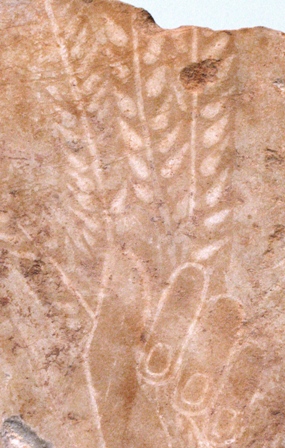
Originally, this would have been painted, and the museum helpfully provides a reconstruction (sorry about the reflection).
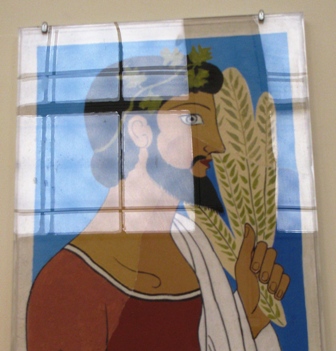
This is part of what the caption says (eccentric spelling etc. in the original):
Depicted is the dead Lyseas in the guise of Dyonisos’ worshiper. He bears a vine wreath on his head, chiton and himation. He holds a kantharos (wine cup) in his right hand and a laurel branch (?) in his left… According to the inscription carved on the base, the stele was erected by Semon on the grave of his son, Lyseas.
Now, about that question mark. I guess it could be laurel, but aren’t depictions of that plant usually in the form of wreaths? Might they not be cereal spikes that Lyseas is holding? Ok, cereal spikes which have lost their awns, but the paint has faded a lot. Cereal spikes like these, admittedly much more naturalistic ones, on a Theran pot. 1
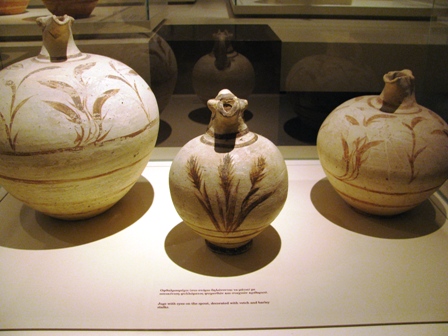
Cereal spikes a bit like these advertizing a modern bakery a short walk from the museum.
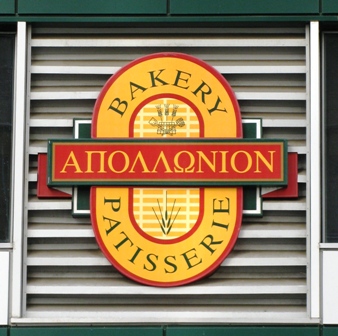
Or like these modernistic renditions, also lacking awns, by the entrance of a branch of a local bank with a focus on agriculture.
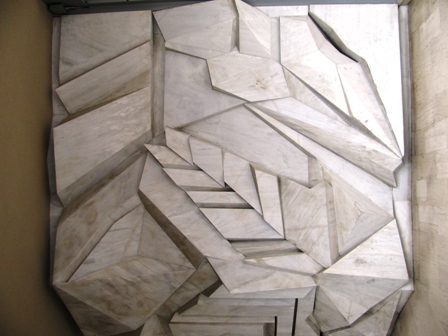
Well, maybe not. It probably was laurel after all. But that question mark…